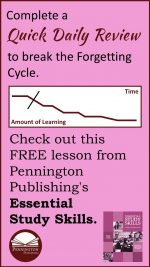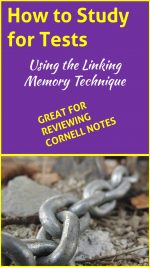Free Resources for Teaching Study Skills
Teachers frequently are shocked by their students’ lack of study skills. Some teachers assume that most study skills are simply common sense and do not need instruction. Or, maybe each teacher thinks that “some other teacher” should or has already taught them. From my own teaching experience, I have come to believe that study skills are not caught, but must be taught.
All content teachers have the responsibility to teach these essential learning skills. Mastering study skills will help your students “work smarter, not harder.” If students learn these skills, they will spend less time, but accomplish more during homework and study time. Students will memorize better and forget less. Their test study will be more productive and students will achieve better grades. Reading comprehension, speed, and retention will improve. Writing will more coherent and essays will be easier to plan and complete.
Following are articles, free resources (including reading assessments), and teaching tips regarding how to teach the essential study skills from the Pennington Publishing Blog. Bookmark and visit us often. Also, check out the quality instructional programs and resources offered by Pennington Publishing.
Study Skills
Essential Study Skills
https://blog.penningtonpublishing.com/study_skills/summer-daily-brainwork/
Looking to prevent summer brain-freeze and help your child get a jump start on the next school year? The tips from Summer Daily Brainwork will teach your child to “work smarter, not harder.” Students who master these skills will spend less time, and accomplish more during homework and study time.
How to Avoid Procrastination
https://blog.penningtonpublishing.com/study_skills/how-to-avoid-procrastination/
This article explains why people procrastinate and gives you the tools that will help replace bad habits with good ones. Learn how to develop a workable plan to avoid procrastination. These practical, easy-to-understand suggestions will help you avoid putting off until tomorrow what you could be doing today.
Learn How to Study
https://blog.penningtonpublishing.com/study_skills/daily-school-and-work-review/
Learning how to study is a skill that is taught, more so than caught. Memory research tells us that we remember up to 70% of new information if that information is practiced within 24 hours. Learn how to practice key information from school and the workplace to interrupt the “forgetting cycle” with the Quick Daily Review.
How to Take Notes
https://blog.penningtonpublishing.com/reading/how-to-take-notes/
Some teachers seem to feel that knowing how to take notes is simply a matter of common sense. However, this is simply not true. Taking effective notes is a skill. Good note-taking can improve comprehension of the information presented in class and in textbooks. It can also help organize for test study. This article teaches the four best strategies for note-taking success: formal outline, webbing, Cornell Notes, and margin notes.
How Margin Notes are Better than the Yellow Highlighter
The key to reading comprehension and retention is interactive reading. To prepare effectively for tests and discussion, marginal annotations prompt that internal dialogue with the author. This article provides the prompts you need to annotate texts well and tells why you should get rid of your yellow highlighters.
How to Get Motivated and Set Goals: The Top Ten Tips
Motivation and goal-setting techniques should work together to produce effective behavioral change. This article will give you the plan to avoid procrastination and develop the discipline needed to achieve your goals.
How to Study: The Top Ten Tips
https://blog.penningtonpublishing.com/study_skills/how-to-study-the-top-ten-tips/
Good students have learned that knowing how to study is just as important as knowing what to study. Good study habits are not just common sense; they have to be learned and practiced. This article discusses how to create a study environment and gives practical tips on how to study effectively.
Six Steps to Active Listening
https://blog.penningtonpublishing.com/study_skills/six-steps-to-active-listening/
Good listening skills need to be learned and practiced. They are not just common sense. Learning new habits to replace old ones takes time and patience. However, everyone can improve listening skills by applying the Six Steps to Active Listening found in this short article.
Top Ten Memory Tips
https://blog.penningtonpublishing.com/study_skills/top-ten-memory-tips/
Improving memory helps in all walks of life: business, school, and relationships. Learning and applying the Top Ten Memory Tips will significantly improve your short and long term memory. Who knows? After reading this list, you just might remember where you left your car keys.
How to Memorize Using the Grouping Technique
https://blog.penningtonpublishing.com/study_skills/how-to-memorize-using-the-grouping-technique/
This simple memory technique will help students of all ages place many items into the long term memory. Using the grouping technique, the seeming trivia of the academic disciplines is organized into meaningful and memorable categories. Score higher on tests and make study fun by learning the way our brains are organized.
How to Memorize Using the Catch Words Technique
https://blog.penningtonpublishing.com/study_skills/how-to-memorize-using-the-catch-words-technique/
Improve your long term memory by using catch words. Students will especially appreciate how catch words will help organize their test study. Catch words are useful for simple day to day facts that need to be memorized. You may also figure out why “ROY G. BIV” has helped millions remember the colors of the rainbow in order.
How to Memorize Using the Catch Sentences Technique
Learn how to significantly improve your long term memory by using catch sentences. Students will especially love how catch sentences will help organize their test study. Catch sentences are useful for many aspects of daily life. You may also figure out why “Every good boy does fine” has helped millions learn to play the piano.
How to Memorize Using the Association Technique
https://blog.penningtonpublishing.com/study_skills/how-to-memorize-using-the-association-technique/
Need to improve your long term memory? The association memory trick will help students prepare more efficiently for tests. The trick will help sales people remember names. Learn how to significantly improve your long term memory by using catch sentences. You may also find out how the memory experts can memorize the names of an entire studio audience.
How to Memorize Using the Linking Technique
https://blog.penningtonpublishing.com/study_skills/how-to-memorize-using-the-linking-technique/
The linking memory technique is one of the best memory methods to memorize lists of seemingly unrelated objects. Learn how to significantly improve your long term memory by using the linking strategies. Once you’ve made a link, you won’t have to think—you’ll just remember.
How to Memorize Using the Location Memory Technique
Location! Location! Location! The real estate professionals haven’t cornered the market on this strategy. Developed by the ancient Greeks, using familiar locations to memorize many ideas or objects has always proved a full-proof method of memorization. Have a speech or business presentation? This article will give you the tools to place the words into your long term memory.
How to Memorize Using the This Old Man Technique
Who would think that a simple nursery rhyme, “This Old Man,” could help you memorize ten completely unrelated items in perfect order. Great for a business presentation. Useful for test study. Wonderful for a grocery or any to-do list. Once learned, the information will be retained in the long term memory.
More Articles, Free Resources, and Teaching Tips from the Pennington Publishing Blog
 English-Language Arts and Reading Intervention Articles and Resources
English-Language Arts and Reading Intervention Articles and Resources
Bookmark and check back often for new articles and free ELA/reading resources from Pennington Publishing.
- Free Teaching Reading Resources
- Grammar and Mechanics
- Vocabulary
- English-language Arts Standards
- English-language Arts Instruction
- Essay Resources and Lessons
- The Writing Process/Writers Workshop
- Writing Style
- Spelling
- Structural Analysis/Syllabication/Oral Language
- ELA/Reading Assessments
- Independent Reading
- Reading Intervention (RtI Resources)
- EL/ESL/ELD
- Assessment-based Individualized Instruction/Differentiated Instruction
- Critical Thinking
- Study Skills
- Test Preparation
- Developmental Characteristics
- Professional Development
- Literacy Centers
- Close Reading
- Reading Comprehension
*****
Pennington Publishing’s mission is to provide the finest in assessment-based ELA and reading intervention resources for grades 4‒high school teachers. Mark Pennington is the author of many printable and digital programs. Please check out Pennington Publishing for assessment-based resources created for teachers by a fellow teacher.







